Hair-Growth-Promoting Effects of Fermented Red Ginseng Marc and Traditional Polyherb Formula in C57BL/6 Mice
Abstract
1. Introduction
2. Materials and Methods
2.1. Preparation of Fermented RGM and Traditional Polyherb Formula
2.2. Animal
2.3. Hair Removal and Treatments
2.4. Macroscopic and Microscopic Assessment
2.5. Histopathology
2.6. Immunohistochemistry
2.7. Statistical Analyses
3. Results
3.1. Components of fRGM
3.2. Effects on Hair Growth Region
3.3. Effects on Hair Length, Thickness and Weight
3.4. Effects on Development of Anagen-Phased Hair Follicle
3.5. Proliferating Effects on Hair Follicle
4. Discussion
5. Conclusions
Author Contributions
Funding
Institutional Review Board Statement
Informed Consent Statement
Data Availability Statement
Acknowledgments
Conflicts of Interest
References
- Mulinari-Brenner, F.; Bergfeld, W.F. Hair loss: An overview. Derm. Nurs. 2001, 13, 269–272, 277–278. [Google Scholar]
- Paus, R.; Cotsarelis, G. The biology of hair follicles. N. Engl. J. Med. 1999, 341, 491–497. [Google Scholar] [CrossRef] [PubMed]
- Trueb, R.M. Molecular mechanisms of androgenetic alopecia. Exp. Gerontol. 2002, 37, 981–990. [Google Scholar] [CrossRef]
- Trueb, R.M.; Dias, M. Alopecia Areata: A Comprehensive Review of Pathogenesis and Management. Clin. Rev. Allergy Immunol. 2018, 54, 68–87. [Google Scholar] [CrossRef] [PubMed]
- Williamson, D.; Gonzalez, M.; Finlay, A.Y. The effect of hair loss on quality of life. J. Eur. Acad. Derm. Venereol. 2001, 15, 137–139. [Google Scholar] [CrossRef] [PubMed]
- Rogers, N.E.; Avram, M.R. Medical treatments for male and female pattern hair loss. J. Am. Acad. Dermatol. 2008, 59, 547–566. [Google Scholar] [CrossRef] [PubMed]
- Lee, S.W.; Juhasz, M.; Mobasher, P.; Ekelem, C.; Mesinkovska, N.A. A Systematic Review of Topical Finasteride in the Treatment of Androgenetic Alopecia in Men and Women. J. Drugs Derm. 2018, 17, 457–463. [Google Scholar]
- Hong, Y.J.; Kim, N.; Lee, K.; Hee Sonn, C.; Eun Lee, J.; Tae Kim, S.; Ho Baeg, I.; Lee, K.M. Korean red ginseng (Panax ginseng) ameliorates type 1 diabetes and restores immune cell compartments. J. Ethnopharmacol. 2012, 144, 225–233. [Google Scholar] [CrossRef]
- Kim, J.Y.; Park, J.Y.; Kang, H.J.; Kim, O.Y.; Lee, J.H. Beneficial effects of Korean red ginseng on lymphocyte DNA damage, antioxidant enzyme activity, and LDL oxidation in healthy participants: A randomized, double-blind, placebo-controlled trial. Nutr. J. 2012, 11, 47. [Google Scholar] [CrossRef]
- Park, G.H.; Park, K.Y.; Cho, H.I.; Lee, S.M.; Han, J.S.; Won, C.H.; Chang, S.E.; Lee, M.W.; Choi, J.H.; Moon, K.C.; et al. Red ginseng extract promotes the hair growth in cultured human hair follicles. J. Med. Food 2015, 18, 354–362. [Google Scholar] [CrossRef]
- Kim, S.N.; Kim, S.; Hong, Y.D.; Park, H.; Shin, S.H.; Kim, A.R.; Park, B.C.; Shin, S.S.; Park, J.S.; Park, M.; et al. The ginsenosides of Panax ginseng promote hair growth via similar mechanism of minoxidil. J. Dermatol. Sci. 2015, 77, 132–134. [Google Scholar] [CrossRef] [PubMed]
- Kim, J.-H.; Yi, S.-M.; Choi, J.-E.; Son, S.-W. Study of the efficacy of Korean red ginseng in the treatment of androgenic alopecia. J. Ginseng. Res. 2009, 33, 223–228. [Google Scholar]
- Yang, W.; Qiao, X.; Li, K.; Fan, J.; Bo, T.; Guo, D.A.; Ye, M. Identification and differentiation of Panax ginseng, Panax quinquefolium, and Panax notoginseng by monitoring multiple diagnostic chemical markers. Acta Pharm. Sin. B 2016, 6, 568–575. [Google Scholar] [CrossRef] [PubMed]
- Kim, S.H.; Jeong, K.S.; Ryu, S.Y.; Kim, T.H. Panax ginseng prevents apoptosis in hair follicles and accelerates recovery of hair medullary cells in irradiated mice. In Vivo 1998, 12, 219–222. [Google Scholar]
- Matsuda, H.; Yamazaki, M.; Asanuma, Y.; Kubo, M. Promotion of hair growth by ginseng radix on cultured mouse vibrissal hair follicles. Phytother. Res. 2003, 17, 797–800. [Google Scholar] [CrossRef]
- Lee, S.Y.; Lee, D.J.; Kwon, K.; Lee, C.H.; Shin, H.J.; Kim, J.E.; Ha, K.T.; Jeong, H.S.; Seo, H.S. Cornu cervi pantotrichum Pharmacopuncture Solution Facilitate Hair Growth in C57BL/6 Mice. J. Pharmacopunct. 2016, 19, 122–128. [Google Scholar] [CrossRef]
- Lee, K.H.; Choi, D.; Jeong, S.I.; Kim, S.J.; Lee, C.H.; Seo, H.S.; Jeong, H.S. Eclipta prostrata promotes the induction of anagen, sustains the anagen phase through regulation of FGF-7 and FGF-5. Pharm. Biol. 2019, 57, 105–111. [Google Scholar] [CrossRef]
- Leem, J.; Jung, W.; Kim, Y.; Kim, B.; Kim, K. Exploring the combination and modular characteristics of herbs for alopecia treatment in traditional Chinese medicine: An association rule mining and network analysis study. BMC Complement. Altern. Med. 2018, 18, 204. [Google Scholar] [CrossRef]
- Zhang, B.; Zhang, R.W.; Yin, X.Q.; Lao, Z.Z.; Zhang, Z.; Wu, Q.G.; Yu, L.W.; Lai, X.P.; Wan, Y.H.; Li, G. Inhibitory activities of some traditional Chinese herbs against testosterone 5alpha-reductase and effects of Cacumen platycladi on hair re-growth in testosterone-treated mice. J. Ethnopharmacol. 2016, 177, 1–9. [Google Scholar] [CrossRef]
- Lee, S.D.; Yoo, G.; Chae, H.J.; In, M.-J.; Oh, N.-S.; Hwang, Y.K.; Hwang, W.I.; Kim, D.C. Lipid-soluble extracts as the main source of anticancer activity in ginseng and ginseng marc. J. Am. Oil Chem. Soc. 2009, 86, 1065–1071. [Google Scholar] [CrossRef]
- Lim, T.S.; Na, K.; Choi, E.M.; Chung, J.Y.; Hwang, J.K. Immunomodulating activities of polysaccharides isolated from Panax ginseng. J. Med. Food 2004, 7, 1–6. [Google Scholar] [CrossRef] [PubMed]
- Yoo, G.; Lee, S.D.; In, M.-J.; Hwang, W.I.; Lee, K.S.; Lee, E.S.; Kim, D.C.; Chae, H.J. An alternative sequential extraction process for maximal utilization of bioactive components from Korean red ginseng. Korean J. Chem. Eng. 2009, 26, 1094–1097. [Google Scholar] [CrossRef]
- Jung, H.-W.; Kim, J.-E.; Seo, J.-H.; Lee, S.-P. Physicochemical and antioxidant properties of red ginseng marc fermented by Bacillus subtilis HA with mugwort powder addition. J. Korean Soc. Food Sci. Nutr. 2010, 39, 1391–1398. [Google Scholar] [CrossRef]
- Chui, C.H.; Cheng, G.Y.; Ke, B.; Lau, F.Y.; Wong, R.S.; Kok, S.H.; Fatima, S.; Cheung, F.; Cheng, C.H.; Chan, A.S.; et al. Growth inhibitory potential of effective microorganism fermentation extract (EM-X) on cancer cells. Int. J. Mol. Med. 2004, 14, 925–929. [Google Scholar] [CrossRef]
- Deiana, M.; Dessi, M.A.; Ke, B.; Liang, Y.F.; Higa, T.; Gilmour, P.S.; Jen, L.S.; Rahman, I.; Aruoma, O.I. The antioxidant cocktail effective microorganism X (EM-X) inhibits oxidant-induced interleukin-8 release and the peroxidation of phospholipids in vitro. Biochem. Biophys. Res. Commun. 2002, 296, 1148–1151. [Google Scholar] [CrossRef]
- Datla, K.P.; Bennett, R.D.; Zbarsky, V.; Ke, B.; Liang, Y.F.; Higa, T.; Bahorun, T.; Aruoma, O.I.; Dexter, D.T. The antioxidant drink effective microorganism-X (EM-X) pre-treatment attenuates the loss of nigrostriatal dopaminergic neurons in 6-hydroxydopamine-lesion rat model of Parkinson’s disease. J. Pharm. Pharm. 2004, 56, 649–654. [Google Scholar] [CrossRef]
- Li, Z.; Li, J.J.; Gu, L.J.; Zhang, D.L.; Wang, Y.B.; Sung, C.K. Ginsenosides Rb1 and Rd regulate proliferation of mature keratinocytes through induction of p63 expression in hair follicles. Phytother. Res. 2013, 27, 1095–1101. [Google Scholar] [CrossRef]
- Choi, J.S.; Jeon, M.H.; Moon, W.S.; Moon, J.N.; Cheon, E.J.; Kim, J.W.; Jung, S.K.; Ji, Y.H.; Son, S.W.; Kim, M.R. In vivo hair growth-promoting effect of rice bran extract prepared by supercritical carbon dioxide fluid. Biol. Pharm. Bull. 2014, 37, 44–53. [Google Scholar] [CrossRef]
- Hou, I.C.; Oi, Y.; Fujita, H.; Yano, Y.; Fukami, H.; Yoshikawa, M. A Hair Growth-Promoting Effect of Chinese Black Tea Extract in Mice. Biosci. Biotechnol. Biochem. 2013, 77, 1606–1607. [Google Scholar] [CrossRef][Green Version]
- Junlatat, J.; Sripanidkulchai, B. Hair growth-promoting effect of Carthamus tinctorius floret extract. Phytother. Res. PTR 2014, 28, 1030–1036. [Google Scholar] [CrossRef]
- Yoon, J.I.; Al-Reza, S.M.; Kang, S.C. Hair growth promoting effect of Zizyphus jujuba essential oil. Food Chem. Toxicol. Int. J. Publ. Br. Ind. Biol. Res. Assoc. 2010, 48, 1350–1354. [Google Scholar] [CrossRef] [PubMed]
- Kim, K.H.; Park, S.J.; Lee, Y.J.; Lee, J.E.; Song, C.H.; Choi, S.H.; Ku, S.K.; Kang, S.J. Inhibition of UVB-Induced Skin Damage by Exopolymers from Aureobasidium pullulans SM-2001 in Hairless Mice. Basic Clin. Pharmacol. Toxicol. 2015, 116, 73–86. [Google Scholar] [CrossRef] [PubMed]
- Hillmann, K.; Blume-Peytavi, U. Diagnosis of hair disorders. Semin. Cutan. Med. Surg. 2009, 28, 33–38. [Google Scholar] [CrossRef] [PubMed]
- Muller-Rover, S.; Handjiski, B.; van der Veen, C.; Eichmuller, S.; Foitzik, K.; McKay, I.A.; Stenn, K.S.; Paus, R. A comprehensive guide for the accurate classification of murine hair follicles in distinct hair cycle stages. J. Investig. Dermatol. 2001, 117, 3–15. [Google Scholar] [CrossRef] [PubMed]
- Datta, K.; Singh, A.T.; Mukherjee, A.; Bhat, B.; Ramesh, B.; Burman, A.C. Eclipta alba extract with potential for hair growth promoting activity. J. Ethnopharmacol. 2009, 124, 450–456. [Google Scholar] [CrossRef] [PubMed]
- Paus, R.; Müller-Röver, S.; van der Veen, C.; Maurer, M.; Eichmüller, S.; Ling, G.; Hofmann, U.; Foitzik, K.; Mecklenburg, L.; Handjiski, B. A comprehensive guide for the recognition and classification of distinct stages of hair follicle morphogenesis. J. Investig. Dermatol. 1999, 113, 523–532. [Google Scholar]
- Hardy, M.H. The secret life of the hair follicle. Trends Genet. 1992, 8, 55–61. [Google Scholar] [CrossRef]
- Stenn, K.S.; Paus, R. Controls of hair follicle cycling. Physiol. Rev. 2001, 81, 449–494. [Google Scholar] [CrossRef]
- Buhl, A.E.; Conrad, S.J.; Waldon, D.J.; Brunden, M.N. Potassium channel conductance as a control mechanism in hair follicles. J. Investig. Dermatol. 1993, 101, S148–S152. [Google Scholar] [CrossRef]
- Katsuoka, K.; Schell, H.; Wessel, B.; Hornstein, O.P. Effects of epidermal growth factor, fibroblast growth factor, minoxidil and hydrocortisone on growth kinetics in human hair bulb papilla cells and root sheath fibroblasts cultured in vitro. Arch. Derm. Res. 1987, 279, 247–250. [Google Scholar] [CrossRef]
- Jindo, T.; Tsuboi, R.; Takamori, K.; Ogawa, H. Local injection of hepatocyte growth factor/scatter factor (HGF/SF) alters cyclic growth of murine hair follicles. J. Investig. Dermatol. 1998, 110, 338–342. [Google Scholar] [CrossRef] [PubMed]
- Yano, K.; Brown, L.F.; Detmar, M. Control of hair growth and follicle size by VEGF-mediated angiogenesis. J. Clin. Investig. 2001, 107, 409–417. [Google Scholar] [CrossRef] [PubMed]
- Seeger, M.A.; Paller, A.S. The Roles of Growth Factors in Keratinocyte Migration. Adv. Wound Care (New Rochelle) 2015, 4, 213–224. [Google Scholar] [CrossRef] [PubMed]
- Dzialo, M.; Mierziak, J.; Korzun, U.; Preisner, M.; Szopa, J.; Kulma, A. The Potential of Plant Phenolics in Prevention and Therapy of Skin Disorders. Int. J. Mol. Sci. 2016, 17, 160. [Google Scholar] [CrossRef]
- Semalty, M.; Semalty, A.; Joshi, G.P.; Rawat, M.S. Hair growth and rejuvenation: An overview. J. Dermatol. Treat. 2011, 22, 123–132. [Google Scholar] [CrossRef]
- Li, W.; Man, X.Y.; Li, C.M.; Chen, J.Q.; Zhou, J.; Cai, S.Q.; Lu, Z.F.; Zheng, M. VEGF induces proliferation of human hair follicle dermal papilla cells through VEGFR-2-mediated activation of ERK. Exp. Cell Res. 2012, 318, 1633–1640. [Google Scholar] [CrossRef]
- Zhang, W.; Liu, H.T. MAPK signal pathways in the regulation of cell proliferation in mammalian cells. Cell Res. 2002, 12, 9–18. [Google Scholar] [CrossRef]
- Van den Biggelaar, F.J.; Smolders, J.; Jansen, J.F. Complementary and alternative medicine in alopecia areata. Am. J. Clin. Derm. 2010, 11, 11–20. [Google Scholar] [CrossRef]
- Bassino, E.; Gasparri, F.; Munaron, L. Protective Role of Nutritional Plants Containing Flavonoids in Hair Follicle Disruption: A Review. Int. J. Mol. Sci. 2020, 21, 523. [Google Scholar] [CrossRef]
- Lee, S.M.; Bae, B.S.; Park, H.W.; Ahn, N.G.; Cho, B.G.; Cho, Y.L.; Kwak, Y.S. Characterization of Korean Red Ginseng (Panax ginseng Meyer): History, preparation method, and chemical composition. J. Ginseng. Res. 2015, 39, 384–391. [Google Scholar] [CrossRef]
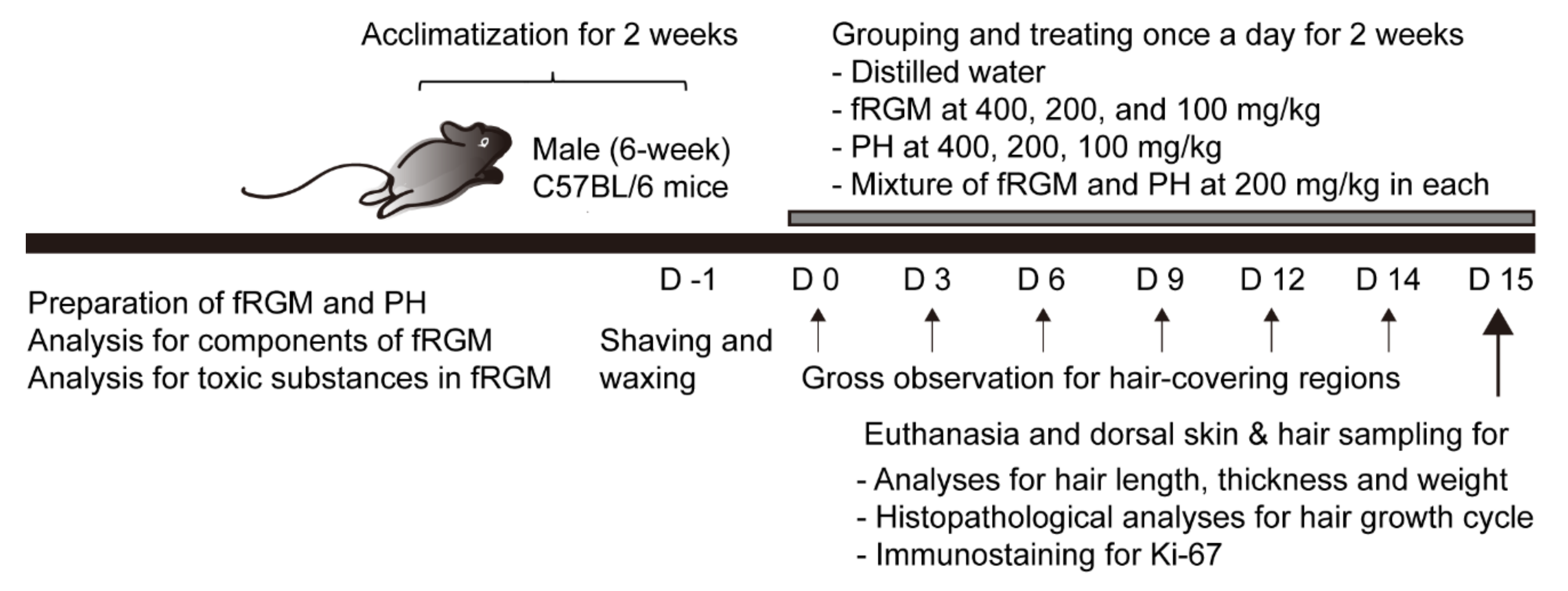

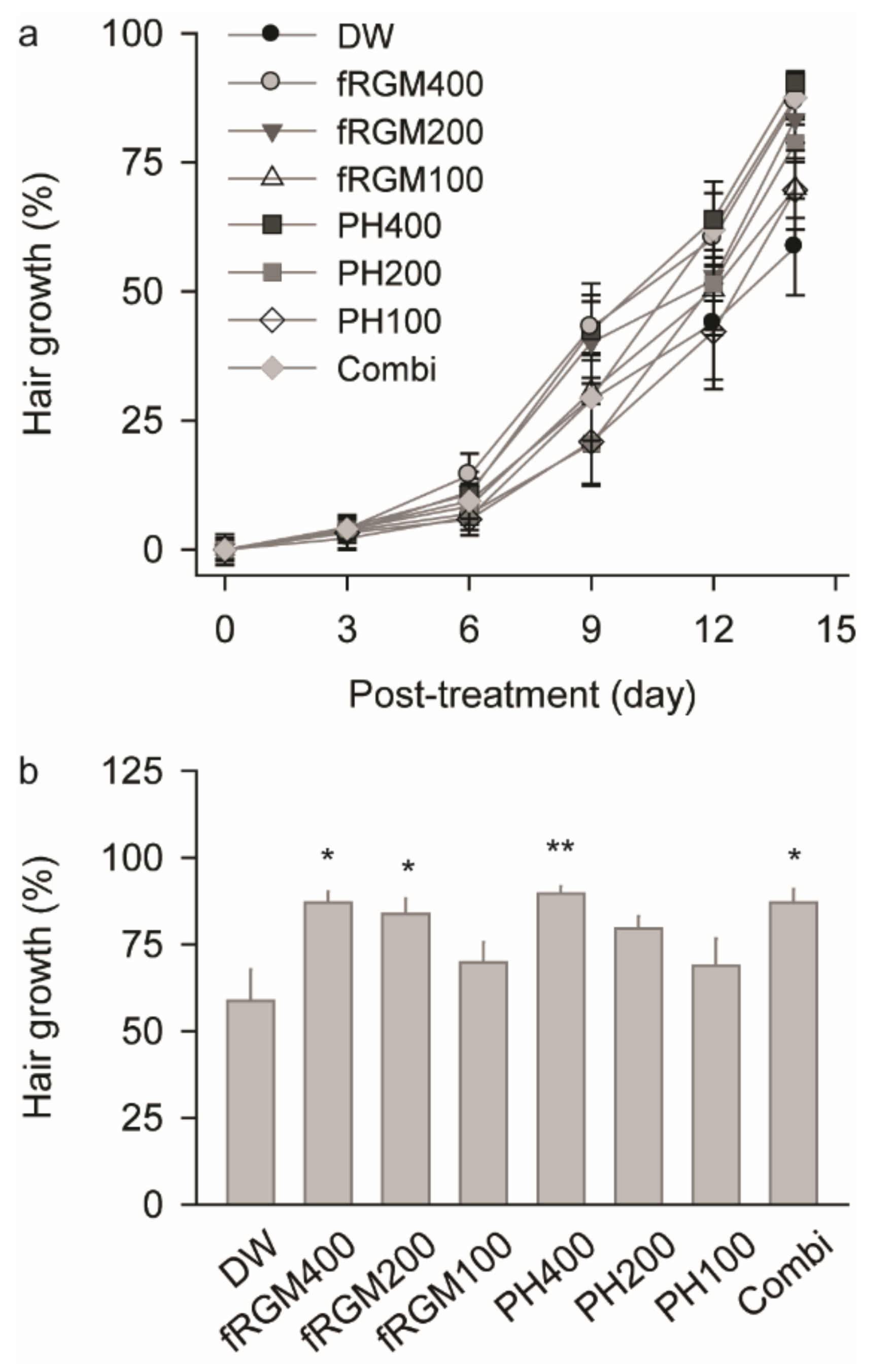
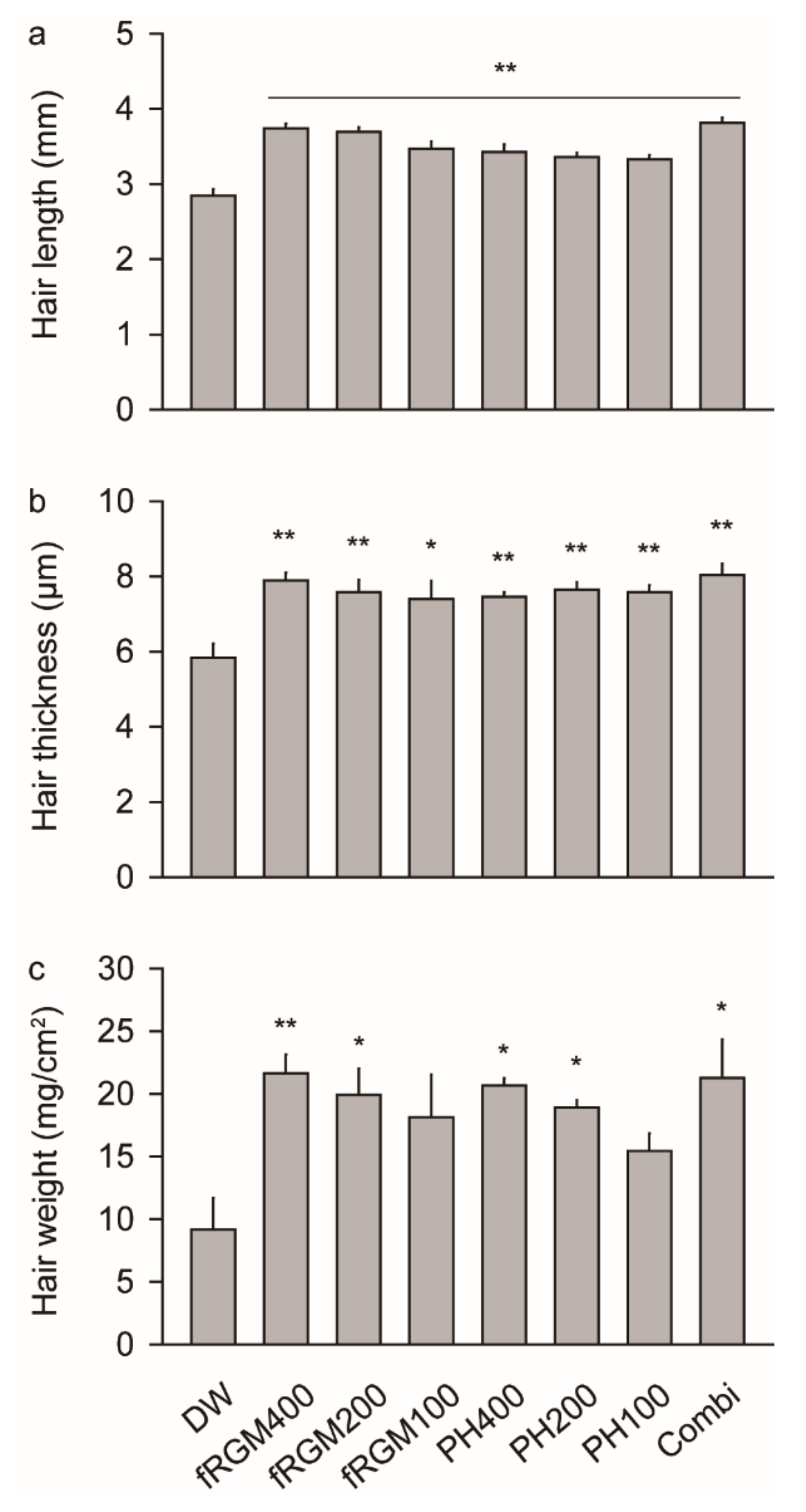
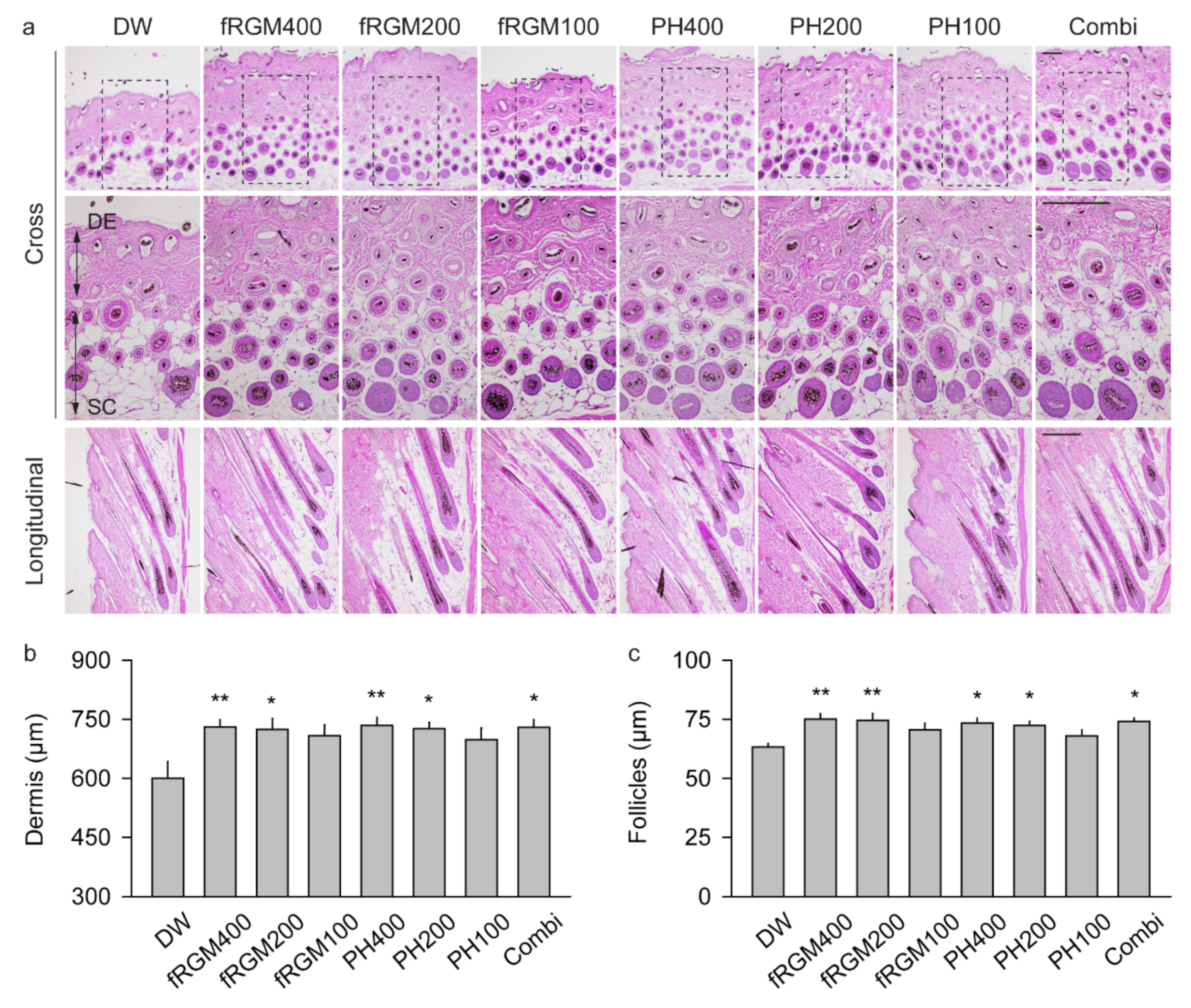
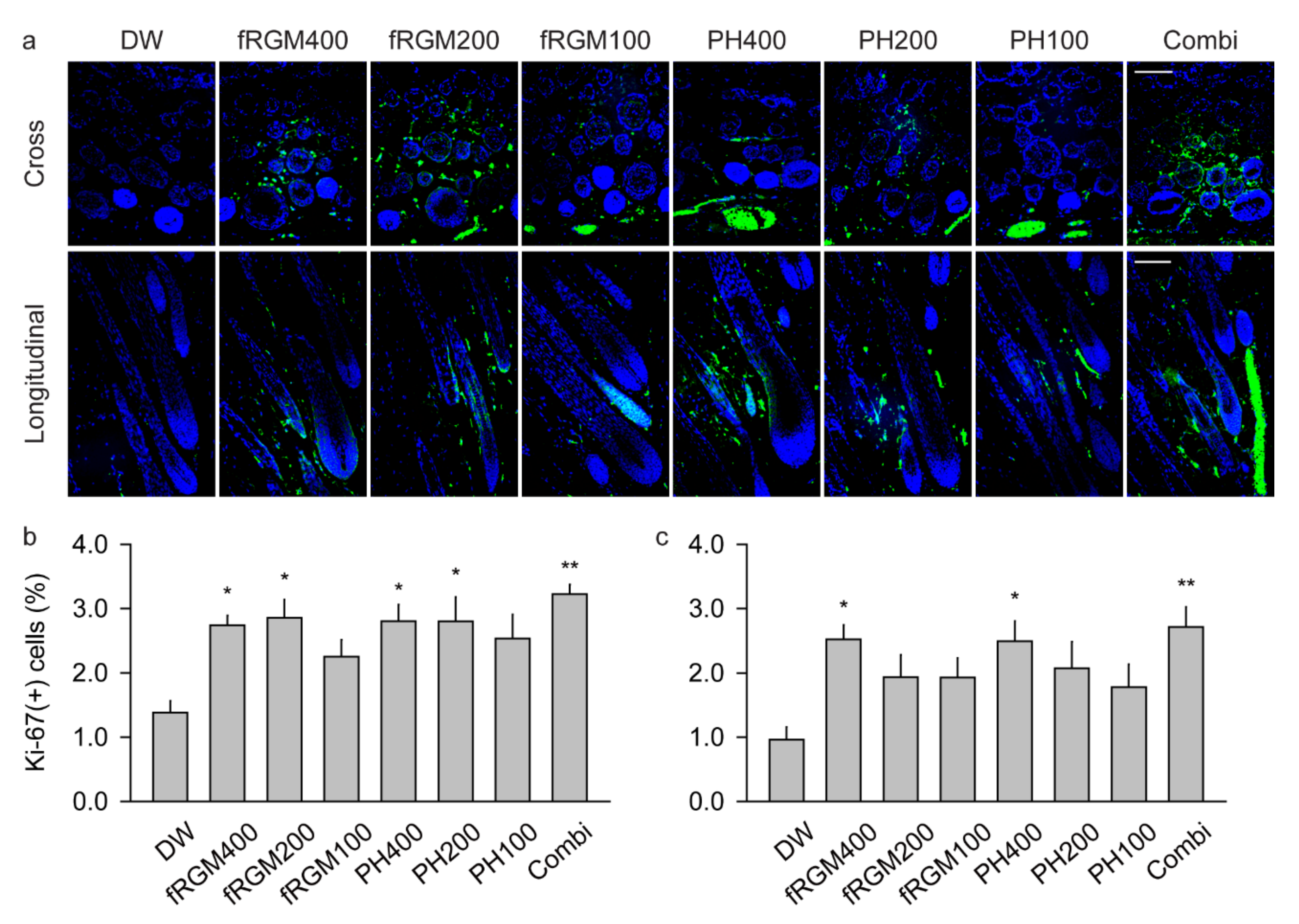
| Herbs | Scientific Name | Amounts |
|---|---|---|
| Pilose Antler | Cornu cervi pantotrichum | 20% |
| Old Antler | Cornu cervi | 60% |
| Ecliptae Herba | Eclipta prostrata L. | 1% |
| Dictamni Radicis Cortex | Dictamnus dasycarpus Turczaininov | 2% |
| Polygoni Multiflori Radix | Polygonum multiflorum Thunberg | 8% |
| Lycopi Herba | Lycopus lucidus Turczaininov | 8% |
| Red ginseng | Panax ginseng C. A. Meyer | 1% |
| Groups | Numbers of Hair Follicle/mm2 (% in Total) | ||
|---|---|---|---|
| Subcutis | Dermis | Total | |
| DW | 26.00 ± 1.68 (52.90 ± 1.39) | 23.47 ± 2.31 (47.10 ± 1.39) | 49.47 ± 3.80 (100) |
| fRGM400 | 38.30 ± 1.93 ** (58.98 ± 0.98) | 26.54 ± 1.03 (41.02 ± 0.98) | 64.85 ± 2.69 * (100) |
| fRGM200 | 37.34 ± 1.71 ** (59.27 ± 2.13) | 25.68 ± 1.59 (40.73 ± 2.13) | 63.02 ± 1.91 * (100) |
| fRGM100 | 33.73 ± 2.80 (56.77 ± 2.04) | 25.32 ± 1.33 (43.23 ± 2.04) | 59.05 ± 3.45 (100) |
| PH400 | 39.88 ± 2.07 ** (59.60 ± 1.83) | 26.98 ± 1.45 (40.40 ± 1.83) | 66.86 ± 2.53 ** (100) |
| PH200 | 38.14 ± 1.81 ** (59.93 ± 0.87) | 25.41 ± 0.77 (40.07 ± 0.87) | 63.55 ± 2.35 * (100) |
| PH100 | 35.88 ± 2.32 * (58.98 ± 1.62) | 24.82 ± 1.33 (41.02 ± 1.62) | 60.70 ± 3.15 (100) |
| combi | 41.26 ± 1.05 ** (59.83 ± 1.33) | 27.97 ± 2.06 (40.18 ± 1.33) | 69.23 ± 2.88 ** (100) |
Publisher’s Note: MDPI stays neutral with regard to jurisdictional claims in published maps and institutional affiliations. |
© 2021 by the authors. Licensee MDPI, Basel, Switzerland. This article is an open access article distributed under the terms and conditions of the Creative Commons Attribution (CC BY) license (http://creativecommons.org/licenses/by/4.0/).
Share and Cite
Song, P.H.; Park, G.-R.; Kim, Y.-H.; Jung, D.H.; Ku, S.-K.; Song, C.-H. Hair-Growth-Promoting Effects of Fermented Red Ginseng Marc and Traditional Polyherb Formula in C57BL/6 Mice. Appl. Sci. 2021, 11, 1195. https://doi.org/10.3390/app11031195
Song PH, Park G-R, Kim Y-H, Jung DH, Ku S-K, Song C-H. Hair-Growth-Promoting Effects of Fermented Red Ginseng Marc and Traditional Polyherb Formula in C57BL/6 Mice. Applied Sciences. 2021; 11(3):1195. https://doi.org/10.3390/app11031195
Chicago/Turabian StyleSong, Phil Hyun, Gyu-Ryeul Park, Yoon-Hae Kim, Dae Hwa Jung, Sae-Kwang Ku, and Chang-Hyun Song. 2021. "Hair-Growth-Promoting Effects of Fermented Red Ginseng Marc and Traditional Polyherb Formula in C57BL/6 Mice" Applied Sciences 11, no. 3: 1195. https://doi.org/10.3390/app11031195
APA StyleSong, P. H., Park, G.-R., Kim, Y.-H., Jung, D. H., Ku, S.-K., & Song, C.-H. (2021). Hair-Growth-Promoting Effects of Fermented Red Ginseng Marc and Traditional Polyherb Formula in C57BL/6 Mice. Applied Sciences, 11(3), 1195. https://doi.org/10.3390/app11031195






